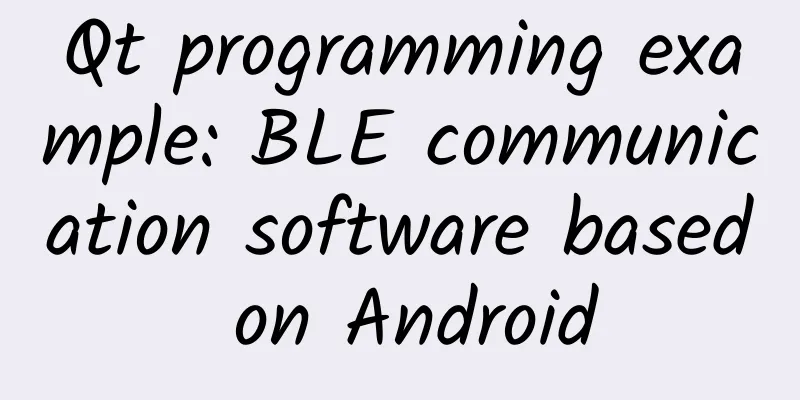Qt programming example: BLE communication software based on Android

|
Achieving goals
Required tools and environment
Source code of this article Because this is the first time to share Qt code, in order to facilitate everyone's learning, a lot of comments have been added to the code, and everyone can learn more efficiently by referring to the code. Reply to the keyword "Android-BLE" in the backend to obtain the software and Qt project source code involved in this article. Specific implementation 1. To use the Qt Bluetooth module, you need to add a declaration to the project's .pro file. 2. Scan Devices Perform a scan for Bluetooth devices in the constructor, that is, as soon as the software starts.
3. Add the scan results to QListWidget
4. Connect Bluetooth and stop scanning
5. Get features
6. Sending Data writeCharacteristic() method to send data to the BLE device. Click the "Send" button in the interface to send the "Hello World" string.
7. Write data Receive messages received by Bluetooth through the Bluetooth QLowEnergyService::characteristicRead callback interface.
8. Disconnect
Interface layout Results If "Cannot connect to remote device." appears, you can click the "Connect" button to reconnect. Serial port assistant and application output To do This example is just to demonstrate the communication process between an Android phone and the TB-02-kit module. There are some areas that need to be improved in the program. For example, a "scan" button should be added instead of directly performing Bluetooth scanning during software startup. In this case, Bluetooth power-on needs to be completed before the software is started. The robustness of the program also needs to be improved. For example, occasionally the module may not be connected properly, and you will need to click the "Connect" button again. You can improve these tasks by yourselves. With this knowledge, the next step is to combine Android phones and TB-02-kit modules to achieve remote control of STM32 devices. Qt Tips 1. Qt Creator program output window filters debugging information 2. Add events to Button Select "Go to slot..." in the right-click menu of the Button control, then select the signal in the pop-up list: "clicked()", and then click the OK button to enter its event function. References Qt official documentation: https://doc.qt.io/qt-5/classes.html This article is reprinted from the WeChat public account "Embedded from 0 to 1", which can be followed through the following QR code. To reprint this article, please contact the Embedded from 0 to 1 public account. |
>>: Talk about the birth and use of AMS
Recommend
Wu Feng's "From English Basics to Interpretation Experts" 2021 Edition
: : : : : : : : : : : : : : : : : : : : : : : : : ...
“Jump Jump” is popular, how can brands leverage this momentum for marketing?
The WeChat mini -game “Jump Jump” has become very...
Why does marketing to women so often fail?
Since entering the 21st century, the rise of fema...
I want to poop right after eating. What's the reason?
Not long after eating, the call of the wild from ...
Real physics terms: Atomic bombs have nothing to do with atoms, and hydrogen bombs have little to do with hydrogen
In scientific research, scientists create proper ...
World Heart Day | "It's the heartbeat!" How much do you know about the heart?
Review expert: Peng Guoqiu, deputy chief physicia...
What are the "little blisters" on your fingers in summer? This article teaches you how to deal with them!
In the hot summer, have you noticed some transpar...
7 Marketing Trends for 2022
Hongxing Erke became a big hit after donating, Mi...
Tik Tok female hacker-mia creates a practical course on differentiated accounts
Tik Tok Female Hacker-mia Creates Differentiated ...
How to optimize 360 Mobile Assistant? Grasp these!
Among the third-party platforms we use, in additi...
Miaopai's rankings from January to June reveal four major trends in the short video industry
From January to now, the entire short video indus...
A late bloomer in anatomy! He became a professor at the age of 60, was elected as an academician at the age of 72, and participated in manned space flight at the age of 80
On August 24, Zhong Shizhen, the founder of moder...
Can blacklisting Taobao help bring manufacturing back to the United States?
In its quest to attract manufacturing back to Chi...
How often should you replace your mobile phone? An experienced technician explains it very straightforwardly
The performance, appearance and advanced technolo...
Why is the volume dropping? Five factors that make APP promotion difficult!
Many CP friends who do channel (especially third-p...

![[Master Hong on Chaos] Breaking Chaos with Chaos, Breaking the Nameless Chaos Theory with Wisdom Course (Second Edition) 2022](/upload/images/67cc0d72affbd.webp)







